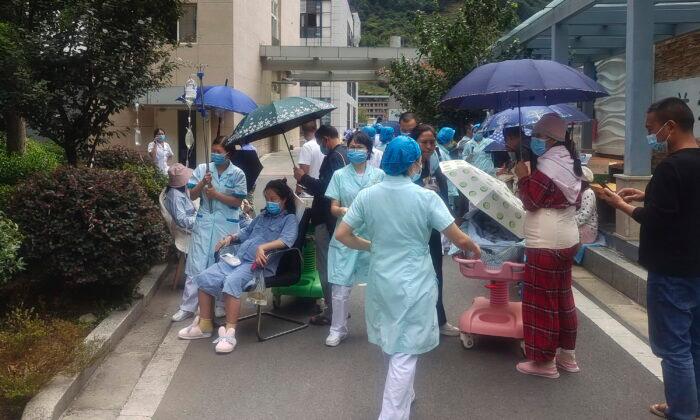BEIJING—Authorities in southwestern China’s Chengdu have maintained strict COVID-19 lockdown measures on the city’s population of 21 million despite a major earthquake that killed at least 65 people in outlying areas.
Footage circulating online Tuesday showed workers wearing top-to-bottom protective gear preventing residents of apartment buildings from exiting through locked lobby doors following Monday’s 6.8 magnitude quake centered in the surrounding province of Sichuan.
Buildings in Chengdu and other parts of western China were shaken by the quake. No damage was reported in the city. The quake struck a mountainous area in Luding county, which sits on the edge of the Tibetan Plateau roughly 200 kilometers (125 miles) from Chengdu, where tectonic plates grind up against each other.
Despite only recording a handful of cases, Chengdu’s lockdown is the most severe since China’s largest city of Shanghai was placed in isolation over the summer, prompting rare protests in person and online.
In all, 65 million Chinese in 33 cities including seven provincial capitals are currently under varying levels of lockdown while the Chinese Communist Party (CCP) is discouraging domestic travel during upcoming national holidays.
Outbreaks have been reported in 103 cities, the highest since the early days of the pandemic in early 2020.
Most Chengdu residents are confined to their apartments or residential complexes. In the eastern port city of Tianjin, classes were moved online after a handful of new cases were reported.
The ruthless and often chaotic enforcement of the Shanghai lockdown led to widespread complaints over shortages of food, medication, and access to health care. In a sign of how little has changed, at least one district in Chengdu has banned even the ordering of takeout meals and coffee, according to a notice posted on the internet.
The CCP has stuck to its hard-line “zero-COVID” policy of compulsory testing, lockdowns, quarantines, and masking despite advice from the World Health Organization and moves by most other countries to open up again since the virus was first detected in the central Chinese city of Wuhan in late 2019.
China on Tuesday reported 1,499 new cases of local infection, most of them asymptomatic. Sichuan accounted for 138 of that total figure.
The quake knocked out power and damaged buildings in the historic mountain town of Moxi in the Tibetan autonomous prefecture of Garze, where 37 people were killed.
Around 150 people were reported with varying degrees of injuries.
Another 28 people were killed in neighboring Shimian county on the outskirts of the city of Ya’an. State media reported 248 people injured, mainly in Moxi, and another 16 people missing.
Three of the dead were workers at the Hailuogou Scenic Area, a glacier and forest nature reserve.
The number of casualties from the earthquake and the actual number of COVID-19 cases may be much higher. China’s data is difficult to verify, as the Chinese regime routinely suppresses or alters information.
Along with the deaths, authorities reported landslides that damaged homes, caused power interruptions, and stranded people behind a newly created lake. One landslide blocked a rural highway, leaving it strewn with boulders.
The earthquake and lockdown follow a heat wave and drought that led to water shortages and power cuts due to Sichuan’s reliance on hydropower.






Friends Read Free